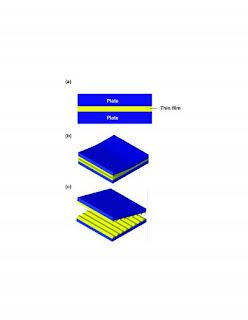“It’s remarkable – and counterintuitive – that fracturing creates these regular patterns,” said chemical engineering professor and dean of Princeton’s graduate school William Russel. Russel and his graduate student Leonard Pease III teamed with Chou and his graduate students Paru Deshpande and Ying Wang to develop the technique.
A patent application has been filed on the process, which the researchers say is economically feasible for large-scale use in industry. The gratings generated by the fracturing process also could be used in conjunction with existing patterning methods. For example, the nanoimprinting method invented by Chou in the 1990s can use the gratings generated by fracture-induced structuring to create a mold that enables mass duplication of patterns with high precision at low cost.
As with many scientific discoveries, the fracture-induced structuring process was happened upon accidentally. Graduate students in the Chou and Russel groups were trying to use instabilities in various molten polymers (in essence, melted plastic) to create patterns when they discovered instead that fracturing a solid polymer film can generate the gratings automatically. The team seized upon this finding and established the optimal conditions for grating formation.
Next, the group plans to explore the fundamental science behind the process and investigate the interplays of various forces at such a small scale, according to Chou.
“And, we want to push the limit and see how small we can go,” he said. ###
Abstract: Self-formation of sub-60-nm half-pitch gratings with large areas through fracturing
Periodic micro- and nanostructures (gratings) have many significant applications in electronic, optical, magnetic, chemical and biological devices and materials. Traditional methods for fabricating gratings by writing with electrons, ions or a mechanical tip are limited to very small areas and suffer from extremely low throughput.
Interference lithography can achieve relatively large fabrication areas, but has a low yield for small-period gratings. Photolithography, nanoimprint lithography, soft lithography and lithographically induced self-construction all require a prefabricated mask, and although electrohydrodynamic instabilities can self-produce periodic dots without a mask, gratings remain challenging. Here, we report a new low-cost maskless method to self-generate nano- and microgratings from an initially featureless polymer thin film sandwiched between two flat relatively rigid plates.
By simply prying apart the plates, the film fractures into two complementary sets of nonsymmetrical gratings, one on each plate, of the same period. The grating period is always four times the thickness of the glassy film, regardless of its molecular weight and chemical composition. Periods from 120 nm to 200 mm have been demonstrated across areas as large as two square centimeters.
Contact: Hilary Parker haparker@princeton.edu 609-258-4597 Princeton University, Engineering School
Technorati Tags: Nano or Nanotechnology and Nanotech and Princeton University or microchips and fracture-induced structuring or Can consumers be confused into buying? and Halloween Ghost Boo, Le fantôme and Two nanostructures are better than one















No comments:
Post a Comment